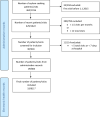Asylum-Seeking Children with Medical Complexity and Rare Diseases in a Tertiary Hospital in Switzerland
- PMID: 33083944
- PMCID: PMC8233290
- DOI: 10.1007/s10903-020-01100-8
Asylum-Seeking Children with Medical Complexity and Rare Diseases in a Tertiary Hospital in Switzerland
Abstract
The aim of this study was to assess the characteristics of asylum-seeking children with medical complexity visiting a tertiary care hospital in Switzerland, detailing their underlying medical conditions and management. Asylum-seeking patients with frequent visits between January 2016 and December 2017 were identified using administrative and electronic health records. Of 462 patients, 19 (4%) fulfilled the inclusion criteria with 811 (45%) visits. The age of the 19 patients ranged from 0 to 16.7 years (median of 7 years) with two main age groups identified: < 2 years and > 12 years. Nine (47%) patients originated from Syria. A total of 34/811(4%) visits were hospital admissions, 66/811 (8%) emergency department visits and 320/811(39%) outpatient department visits. In children < 2 years genetic diseases (5/8; 63%) and nutritional problems (6/8; 75%) were most common; in adolescents, orthopedic diseases (4/8; 50%) and mental health problems (4/8; 50%). Asylum-seeking children with medical complexity represent a small but important group of patients requiring frequent medical consultations. The high proportion of young patients with genetic diseases and severe nutritional problems suggests that new strategies are required in the management of this specific group of asylum-seeking children. This could be achieved by improved co-ordination between hospital and non-hospital care exploring options for integrated care.
Keywords: Chronic diseases; Europe; Genetics; Migrant health; Refugee minors.
Conflict of interest statement
The authors declare that they have no conflict of interest.
Figures




Similar articles
-
Health care provided to recent asylum-seeking and non-asylum-seeking pediatric patients in 2016 and 2017 at a Swiss tertiary hospital - a retrospective study.BMC Public Health. 2021 Jan 7;21(1):81. doi: 10.1186/s12889-020-10082-z. BMC Public Health. 2021. PMID: 33413242 Free PMC article.
-
Preventable admissions and emergency-department-visits in pediatric asylum-seeking and non-asylum-seeking patients.Int J Equity Health. 2020 May 1;19(1):58. doi: 10.1186/s12939-020-01172-w. Int J Equity Health. 2020. PMID: 32357879 Free PMC article.
-
Reasons for admission in asylum-seeking and non-asylum-seeking patients in a paediatric tertiary care centre.Swiss Med Wkly. 2020 May 27;150:w20252. doi: 10.4414/smw.2020.20252. eCollection 2020 May 18. Swiss Med Wkly. 2020. PMID: 32459858
-
Prevalence of mental disorders in young refugees and asylum seekers in European Countries: a systematic review.Eur Child Adolesc Psychiatry. 2019 Oct;28(10):1295-1310. doi: 10.1007/s00787-018-1215-z. Epub 2018 Aug 27. Eur Child Adolesc Psychiatry. 2019. PMID: 30151800 Free PMC article.
-
Impact of professional interpreters on outcomes for hospitalized children from migrant and refugee families with limited English proficiency: a systematic review.JBI Evid Synth. 2020 Jul;18(7):1360-1388. doi: 10.11124/JBISRIR-D-19-00300. JBI Evid Synth. 2020. PMID: 32813387
Cited by
-
Challenges in the Medical and Psychosocial Care of the Paediatric Refugee-A Systematic Review.Int J Environ Res Public Health. 2022 Aug 26;19(17):10656. doi: 10.3390/ijerph191710656. Int J Environ Res Public Health. 2022. PMID: 36078371 Free PMC article.
-
Health care provided to recent asylum-seeking and non-asylum-seeking pediatric patients in 2016 and 2017 at a Swiss tertiary hospital - a retrospective study.BMC Public Health. 2021 Jan 7;21(1):81. doi: 10.1186/s12889-020-10082-z. BMC Public Health. 2021. PMID: 33413242 Free PMC article.
-
Mental Health and Wellbeing of Population with Migrant Background in Switzerland - a Scoping Review and Evidence Map of Quantitative Evidence.J Immigr Minor Health. 2023 Oct;25(5):1108-1117. doi: 10.1007/s10903-023-01490-5. Epub 2023 May 26. J Immigr Minor Health. 2023. PMID: 37237054 Free PMC article.
References
-
- UNHCR. Statistiken 2017. https://www.unhcr.org/dach/ch-de/publikationen/statistiken. Accessed 21 Aug 2018.
-
- Eurostat. Statistiken über Asyl 2017. https://ec.europa.eu/eurostat/statistics-explained/index.php?title=Asylu.... Accessed 31 July 2018.
-
- SEM. Statistik UMA 2017. https://www.sem.admin.ch/dam/data/sem/publiservice/statistik/asylstatist.... Accessed 30 Dec 2018.
-
- WHO. Report on the health of refugees and migrants in the WHO European Region: no public health without refugee and migrant health 2018. https://www.euro.who.int. Accessed 20 Feb 2019.
-
- EUROPE WROF. Strategy and action plan for refugee and migrant health in the WHO European Region 2016. https://www.euro.who.int/__data/assets/pdf_file/0004/314725/66wd08e_Migr.... Accessed 22 Oct 2018.
MeSH terms
LinkOut - more resources
Full Text Sources
Medical

